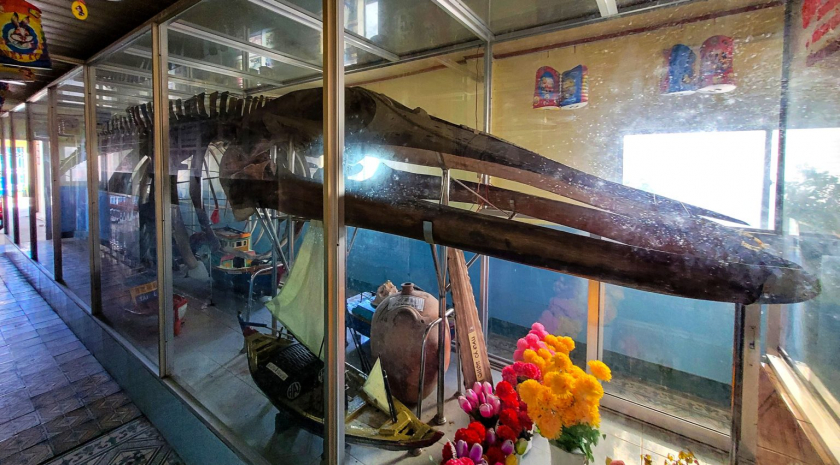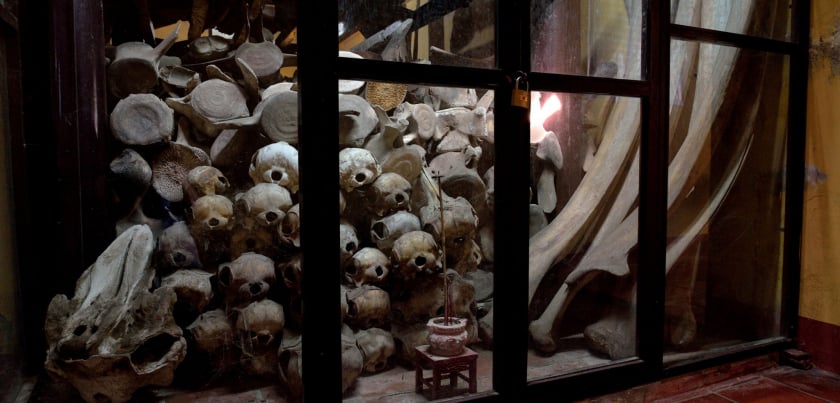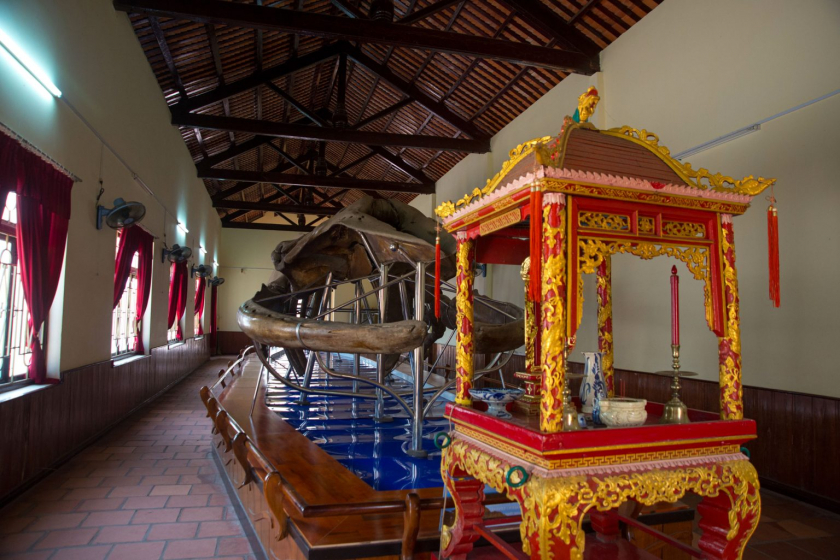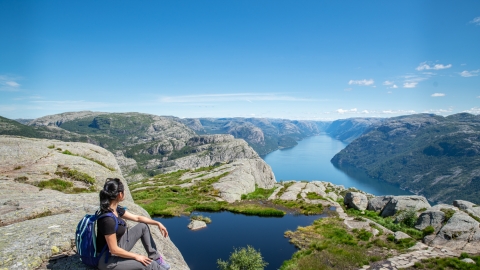Lang Ong Thuy Tuong - the temple of the sea god - is one of more than 1,000 temples along Vietnam's 3,260 km coastline. The afternoon sun beats down on the coastal town of Can Thanh in southern Vietnam, but inside Lang Ong Thuy Tuong, a pale yellow one-story building on the shore, the air is always cool.
Sunlight streamed into the main hall, and the scent of incense filled the air. A man, possibly a fisherman, entered the hall, walked toward a 20-meter-long whale skeleton displayed in a glass case in the center of the temple, clasped his hands and bowed his head in deep reverence.

Whale Temple in Can Thanh.
At these temples, locals worship whale skeletons, of various sizes and shapes, in the hope that their prayers will be carried to Ca Ong, the whale god, for safe voyages and bountiful catches. Relatives of fishermen also regularly visit the temples to light candles, burn incense and pray for safety. Sometimes they offer fruits and votive paper money, hoping their prayers will be heard.
A place to keep history
For more than two centuries, fishing communities along the central and southern coasts of Vietnam have built many places of worship for the carcasses of marine animals that washed ashore.

Temple of whales and sea mammals in Phan Thiet.
From grand architectural structures to small, simple wooden tombs strewn with incense and flowers, these “whale temples” are part of the country’s cultural history that dates back centuries, as well as a testament to its natural history. Vu Long, co-founder of the Ho Chi Minh City-based Center for Biodiversity and Endangered Species (CBES), visited the Whale Temple.
"In addition to being a unique aspect of Vietnamese culture, these temples are also a great source of information for our research," said Mr. Vu Long.
Stories from the skeletons
Mr. Le Van No, a 71-year-old retired fisherman, has been a volunteer caretaker of the shrine for more than 20 years. He comes to clean the shrine every day, and together with others decorates the shrine on special occasions, such as the Nghinh Ong festival held annually in the eighth lunar month.
Lang Ong Thuy Tuong is one of the famous ancient temples dating back to 1805. So Mr. No wanted to share the story of the whale skeletons behind the glass - just one of dozens associated with this temple. The other skeletons are arranged in rooms or stored in 17 coffin-like boxes located on a nearby plot of land. "Locals found this whale with bullet holes. It was another victim of war," Mr. No said.

Vu Long, marine animal researcher.
Mr. No showed Mr. Long a black-and-white photo from 1971 and recounted the time when the whale carcass was found floating in the sea near the temple. Mr. No, then only 20 years old, remembered that the whale carcass was about 13 benches long, very difficult to move by human power alone.
So the locals used a small motorboat to tow the whale carcass to a nearby mangrove forest. The whale carcass decomposed for several months before the skeleton was moved to the temple.
In Da Nang, about 1,000 kilometers north of Can Thanh, fisherman Tran Van Mui, 35, has been praying at Van Nam Tho Pagoda since he was a child. In an earlier interview with Mr. Long, he heard about Mr. Mui’s belief in the miraculous power of whales.
In 2005, Mr. Mui and his fishing crew avoided a storm that the weather forecast had not predicted. At sea, his crew observed the whales surfacing and heading toward shore, taking it as a sign from Mr. Whale. They set off home earlier than planned. By doing so, Mr. Mui believed they had avoided the storm, and their lives were saved.
According to Mr. Long, the deep belief in the mystical power of whales can be traced back to three stories with different origins. One is Hindu and the other Buddhist, but the most widely believed belief in Vietnam is rooted in the country’s history.

Whales are sacred animals often worshiped in temples near the sea.
In the 18th century, during a battle, Lord Nguyen Anh was in danger of being captured. He prayed to the gods for a way to escape. At that moment, 2 whales rose from the sea and took Nguyen Anh's boat out of the siege.
Later, when he ascended the throne, in gratitude, Nguyen Anh declared that all whales in Vietnam's waters should be worshiped as gods. Therefore, fishermen considered it their duty to collect whale carcasses floating in the sea or washed ashore and bury them. After 3 years or so, fishermen would bring the whale's bones to the village temple.


































